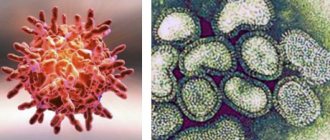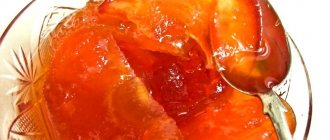What are the benefits of persimmon?
Persimmon is a real storehouse of vitamins. It contains microelements such as glucose and fructose, rutin, calcium and magnesium, iron - the main wealth of persimmons, iodine, pectin, fiber and tannins, but persimmon contains very few calories. Thanks to such a rich composition, persimmon protects the cells of our body, improves metabolism, enriches the blood, has a beneficial effect on digestion, and helps the thyroid gland. And these are not all the advantages of this autumn delicacy.
It is very important to know at what age you can give your child persimmon, because the vitamin C it contains is very beneficial for the child’s body, and every mother wants her child to receive as much of it as possible. Thanks to vitamin C, it is easier for a child’s body to fight autumn colds and various infections. Persimmon has a beneficial effect on children's immunity, strengthens the bones of a growing body and improves metabolism.
Complementary feeding with dairy products
We start with kefir, it’s best to make it yourself using special starter cultures that are sold in pharmacies, this is 100% sure that the product is environmentally friendly. It is advisable not to feed cottage cheese until the age of three, as it is too heavy for a child’s unformed body.
You can feed goat milk, but not in large quantities. Give no more than 3 times a week. Banana can also be fed from 4 months. A very useful product. Contains protein, which is similar to meat, and is very nutritious.
Meat can be fed from 9 months: rabbit, calf, chicken, turkey, that’s it. Pork and lamb are prohibited due to their fat content and difficult to digest. Only boiled meat. Fried foods are strictly contraindicated. Boil during cooking, drain, then cook thoroughly. Grind thoroughly and serve with broth.
Fish from 10-11 months. Give only boiled. Try to choose a variety with the least amount of bones and fat. Of course, get rid of the bones before eating. Give in place, having previously crushed the broth.
With breastfeeding, in terms of food, everything is the same, but complementary foods need to be introduced later, from 6-7 months. Another difference is that you can immediately start with dairy products.
Important! Any new product that is introduced for the first time should be given strictly in small quantities. On the tip of a teaspoon. We see how the baby reacts, and only then we begin to gradually increase the volume. Do not introduce more than one new product at a time, so as to clearly know which product may cause a reaction. It would not be a bad idea to consult with a specialist in this field.
Eat healthy food, grow healthy.
The topic of introducing complementary foods is a field for all sorts of speculation and myths. They try to feed the little ones with everything! For example, it is argued that fruits in the form of purees and juices are not the first complementary foods at all, but only their predecessor, and that they are quite suitable for children of 3 months. There is an opinion that at 4 months the baby should already eat 100 grams of vegetable puree, and by 5 months he should be able to master porridge with milk.
Some people, due to lack of awareness, try to offer their babies vegetable puree as early as 1-3 months
This complementary feeding technique existed before; it was approved by the Ministry of Health and the Research Institute of Nutrition of the Russian Academy of Medical Sciences back in 1999, but a lot of time has passed since then and science has refuted all these provisions. Today, the introduction of complementary foods is carried out according to the recommendations of the WHO and the International Dairy League.
The question of the first feeding is very pressing, so today we will dwell in detail on all the exciting points. We will tell you about the timing of the start of complementary feeding, signs of readiness of the body and other important facts.
When can you give persimmon?
Answering the question from how many months can a child be given persimmons and whether persimmons can be given to children under one year old, doctors unanimously answer: “No!” The fact is that at this age, children are still, as a rule, breastfed; their digestive system is accustomed to tender and easily digestible food. Such a sharp and viscous fruit as persimmon will be very difficult to digest, and it is possible that the body will not accept it at all. The tannins contained in persimmons in large quantities are very harmful to the delicate digestive system of infants. A large amount of tannins is also harmful for small children: they lead to intestinal obstruction and very painful sensations. Persimmons are not at all beneficial for children under one year of age, but on the contrary, they are harmful! A nursing mother should not eat this fruit either, so that tannins and tannins do not enter the baby’s body through breast milk.
Is it possible to give persimmon to a one-year-old child? By this age, the digestive system is already strong enough and is able to digest more complex foods than breast milk. Doctors still have not come to a consensus whether to give persimmon to a child from one year of age or later. This is already individual. You can offer your child a small piece to try. If he eats with pleasure, and this does not affect the child’s stomach in any way, you can give it in small quantities, gradually increasing the portions. Some children do not like persimmons at this age, again due to the specific taste and viscosity. There is no point in insisting or rushing the child. The time will come, and the baby himself will begin to ask his mother for this delicacy. As an alternative for being rich in vitamins, you can offer dried persimmon: it is sweeter, not astringent and pleasant to children's taste. As a rule, her babies eat more willingly.
Doctors unanimously say that persimmons can and should be introduced into children’s diets from 2-3 years of age. There is no danger to the digestive system here. But you should adhere to a sense of proportion: do not overfeed the baby, so as not to cause bowel upset or allergic reactions. It is recommended to remove the peel from persimmons, because they have the highest tannin content and are difficult to digest.
A crunchy treat for a baby: crackers, bagels, crackers or baby cookies?
According to children's nutritionists, the best snack for children under one year old from this group of products will be special children's cookies, and not crackers, crackers or bagels. It is dry children's cookies - not shortbread or biscuit - that are considered suitable for babies at this age. It can be introduced into the diet from about 6 months. These cookies easily dissolve in the milk mixture, which allows you to get not only a snack, but also a full breakfast or afternoon snack.
Children's cookies contain wheat flour, milk powder, invert syrup from glucose and fructose, butter (make sure there is no margarine - it is often included in counterfeits!). The recipe also contains malt from barley grains, which retains all their beneficial properties (especially barley malt contains a lot of B vitamins), giving the product a pleasant aroma and extending shelf life. Some types of cookies add vitamins and minerals that babies often lack, for example D, A, E, iron, iodine. Starch and baking powder give the liver volume, vanilla sugar improves the taste, and lecithin helps the absorption of fats.
Diet biscuits for children
At the next stage, after crumbly children's cookies, pediatricians allow you to introduce the baby to biscuits. It is dietary, low-calorie, hypoallergenic and at the same time satisfying. It contains carbohydrates, plant proteins and B vitamins, which are found in wheat.
Galette cookies are made from flour and water, there are no other additives. Some varieties do not even contain sugar and fat, and some do have them, but in such small quantities that the cookies are still considered dietary. As a rule, flavorings are not added to biscuits. They contain leavening agents that are safe for children.
To make the cookies crumbly, they are made using a special technology that allows you to roll out the dough as much as possible (up to 0.2 mm) and then connect the layers to each other - up to 30–40 layers. The result is a fragile, airy delicacy. Thanks to this, the biscuits easily dissolve under the influence of saliva and are not dangerous for baby teeth and delicate stomachs.
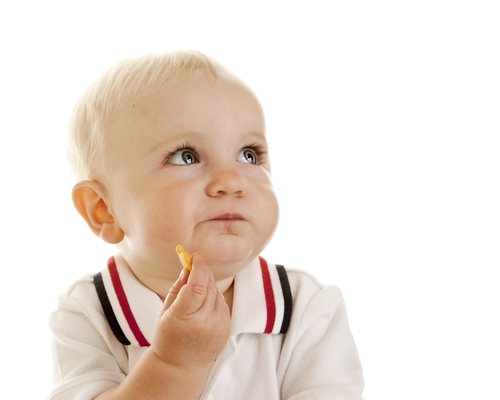
Safe crackers for children
At about two years of age, baby crackers can be introduced into your baby’s diet. They are made using technology that ensures their safe use by children. After three years, crackers for adults with various additives - raisins, nuts, poppy seeds - are acceptable in the diet of children.
Remember that crackers are better absorbed by the body than fresh bread. The fact is that during drying of bread, its structure changes. Moisture and unnecessary elements that weigh down the product evaporate from it. But at the same time, carbohydrates remain in the light-structured crackers, which are instantly absorbed and give the body energy. In addition, due to the lack of moisture, they are stored for a long time, and fresh bread quickly becomes moldy.
Crackers come in buttery varieties - they contain butter, sugar and all kinds of additives. They are no longer considered dietary, so you shouldn’t offer them to kids too often. It is enough to give them 2-3 times a week with tea, jelly, yogurt, and milk.
You can make simple crackers, dried from regular bread, yourself. Just remember that children under four or five years old should not be given crackers made from bread baked from wholemeal flour, as well as from rye or with bran. Only products made from white wheat bread are suitable for them.
However, you shouldn’t overuse crackers. They are low in moisture and high in carbohydrates, so if a child eats them too often, he may suffer from constipation. Also, do not give your baby crackers without any liquid.
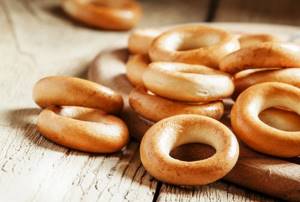
Drying for children: make sure that there is no margarine in the composition
The composition of sushi, bagels and bagels is simple: premium wheat flour, yeast, butter, water. Sometimes they contain natural poppy and mustard seeds, vanilla sugar. Preservative additives are not added to these products, because special preparation technologies allow them to be stored for a long time without compromising freshness. Dry bread is even called “canned bread”.
When buying baked goods, bagels and bagels for your baby, make sure that they do not contain margarine, as trans fats have a bad effect on blood vessels and the stomach.
They should also not contain artificial flavors, which can cause an allergic reaction.
It is not the best food for children that contains yeast, since it is difficult to digest and sometimes even provokes dysbiosis.
The process of preparing sushki and bagels makes them quite suitable for children's food starting from the age of three, since the technology for their production involves only baking, scalding or steaming.
Unlike sushi and bagels, bagels are rich products; they contain more butter or margarine, so they are not suitable for frequent use in children's diets.
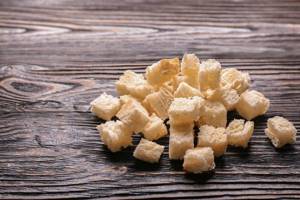
However, they contain carbohydrates that can provide long-lasting energy, as well as B vitamins. Moreover, freshly prepared bagels simply melt in your mouth! Therefore, it is quite possible to pamper your baby with a delicious breakfast once a week.
Sushki are served with jelly, milk and kefir for an afternoon snack (children especially like the “Shuttle” variety because of its softness and crumbliness).
By the way, you can make sushi and bagels yourself at home.
Knead the dough, form into rings, boil them in boiling water until they float, and then, after drying, bake in the oven. You can add poppy seeds, condensed milk, ground nuts, and raisins to the dough. Dry baked goods prepared at home are much healthier than factory-made ones, because you will know for sure that there are no artificial additives in your dry breads, bagels and bagels.
Note to mom
When introducing dry baked goods into the diet of children under one year old, you need to remember some of the dangers that these products can pose to the baby.
Firstly, the child may choke on crumbs, since he does not yet have teeth to thoroughly chew the pieces. For infants, it is recommended to soak dry cookies or place them in special bags made of durable nylon mesh - nibblers. Small pieces, pressed through the mesh and fairly moistened with the saliva of the crumbs, are easy to swallow and cannot be choked on.
Secondly, dry baked goods made from wheat flour contain gluten, which can cause an allergic reaction. So give it a little at a time and watch the reaction.
Thirdly, such products in dry form can injure the mucous membrane of the esophagus and stomach, so they should always be given with liquid - juice, jelly, milk.
Can persimmons cause harm?
An allergy to persimmon in children can appear from the very first piece eaten. The child may develop skin rashes or even angioedema (rare). If you have allergy symptoms, you should not give persimmon to your child; it is better to replace it with some less allergenic fruits, after consulting with your doctor.
Children who have diabetes, excess weight, or problems with the digestive system, in particular, frequent constipation, should not eat persimmons. In such cases, persimmons should not be consumed either fresh or dried. It is not recommended to consume persimmons for children suffering from frequent urination, because the potassium contained in persimmons activates the functioning of the kidneys.
It is dangerous for a child’s body to drink persimmons with cold water or milk: this will inevitably lead to intestinal upset.
So, despite the numerous beneficial properties of the miracle persimmon fruit, one should not rush to introduce it into the children's diet. It is better to do this gradually, listen to the reaction of the child’s body, and under no circumstances force the child to eat persimmon if he does not want to. Everything has its time. Or maybe the baby will appreciate persimmon dishes in which it tastes more pleasant: dried persimmon, persimmon pancakes and casseroles, porridge with the addition of fruit pulp. Experiment and find new tastes. Health to you and your baby!
When can you give lamb?
It is not recommended to introduce lamb before one year of age. Moreover, it should be exclusively lamb or young lamb. In case of weak digestion and intestinal problems, it is better to postpone the introduction until the age of two or three years. The famous children's doctor Komarovsky advises introducing lamb last among various types of meat due to its increased fat content and calorie content.
Lamb is given already when the main types of meat are introduced into complementary foods. These are chicken, turkey, beef and rabbit. For the first test, prepare chopped lamb and give half a teaspoon of the dish to taste.
Carefully observe the baby's reaction, as signs of poisoning or food allergies may appear. The most common symptoms of allergies include swelling, body rash, and itchy skin. You may also notice nasal congestion and runny nose, red and irritated eyes, and watery eyes.
Sometimes nausea, vomiting and abdominal pain occur. The most dangerous is difficulty breathing caused by internal swelling of the airways. In this case, immediately eliminate lamb from your diet and contact your pediatrician. For more information on how to recognize food allergies in a small child and what to do in this case, see here.
If the baby feels well and there are no negative consequences, you can periodically give the baby lamb. In the first months, give no more than 40-50 grams of meat at a time. Gradually increase the amount to 100 grams. Feed your baby this type of meat no more than twice a week.
Lamb should not be given to people with food allergies, diseases of the liver and kidneys, pancreas and gallbladder, arthritis and high acidity of the stomach. It is not recommended for atherosclerosis, high blood pressure and gout.
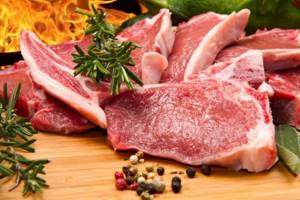
Basic principles
This article talks about typical ways to solve your issues, but each case is unique! If you want to find out from me how to solve your particular problem, ask your question. It's fast and free
!
How to introduce complementary foods correctly? At what age can a child be fed? The main condition for starting complementary feeding is that the child is six months old, regardless of the type of feeding. Breastfed, mixed or bottle-fed infants should receive complementary foods based on the following important factors:
- The main food is milk or formula. Be sure to prioritize breastfeeding or formula feeding for up to a year. WHO experts are convinced that breastfeeding is justified until the age of two and beyond. Such conclusions are based on studies of the composition of breast milk, which, as the baby grows, adapts to the changing needs of the child’s body. It contains useful substances for the proper formation of the brain, nervous and immune systems.
If possible, breastfeeding should be continued for at least a year
- Complementary foods are introduced for familiarization. In no case should you exceed the volumes specified in the standards, otherwise there is a danger of overfeeding the child. The first feeding of an infant is not aimed at satiation; for this purpose, breast milk or an adapted formula, which have great nutritional value, is preserved. Adult food allows you to introduce the baby to a variety of tastes, helps teach the correct functioning of the jaws, ensures the baby’s socialization and teaches proper eating.
- No violence when introducing new products. The introduction of complementary foods should be based on the child’s desire and interest in food.
- Do not use recreational methods when feeding. Fairy tales, jokes, and even more so cartoons are absolutely inappropriate at the table. The child should be interested in the new process, and this can be achieved by regularly seating the baby at the common parental table.
- Pay attention not to deadlines, but to the child. Starting from six months, you can start the first initial complementary feeding, but if the child is not ready yet, there is no need to rush and artificially adjust him to the specified norms. Focus on the level of his health and development.
What should not be given before one year?
- Juices. Often, compassionate grandmothers recommend giving them to their granddaughters and grandchildren, but do not rush to do this. When can complementary foods be introduced to a child in the form of juices? It is advisable to either not give juices at all, or give them after a year. They do not provide any benefit, but they can seriously irritate the mucous surface of the stomach and intestines.
- Fresh vegetables. They contribute to the appearance of bloating and are more difficult to digest compared to boiled options.
- Cookies and any sweets.
- Overseas fruits from tropical countries.
- Cow and goat milk.
The worries that are common to all young parents during the first months of a child’s life have subsided. The mother has decided on the diet necessary for breastfeeding or selected a suitable formula for the baby. But the baby is growing and even supporters of long-term breastfeeding are thinking about complementary feeding by the time the child is six months old. Parents of artificial babies begin to worry about this issue much earlier, since even the most ideal mixture is not able to fully satisfy the needs of infants for vitamins and minerals. The first feeding of a baby raises a lot of questions and doubts among inexperienced parents. Grandmothers, acquaintances, experienced mothers and pediatricians often advise different things, but the baby’s well-being depends on when and how correctly complementary foods are introduced.
When can complementary foods be introduced?
Soviet pediatricians adhered to strict rules for feeding infants, so the opinion of our grandmothers, who know exactly how many months complementary foods are introduced, is often based on universal recommendations that are the same for everyone. Modern doctors believe that a baby’s readiness to absorb adult food is formed individually, so it is necessary to begin introducing complementary foods, focusing on the signs of the baby’s readiness for this process. Factors that indicate that the baby is ready for the introduction of complementary foods are:
- Doubled weight
- The baby’s ability to hold an object in his fist and pull it into his mouth
- Ability to sit and reach for a spoon, leaning forward, or lean back (turn the head away), rejecting food offered
- Interest in the food parents eat
- The ability of a baby to drink water from a spoon without pushing the spoon out of his mouth or spilling water on his chin
You need to start introducing complementary foods only when the baby can no longer get enough breast milk (the mother gives both breasts at one feeding, but the baby clearly wants more). For a formula-fed baby, an indicator of the need to introduce complementary foods is the need to eat more than a liter of formula per day. Since the stomach of a baby up to 6 months is not able to properly digest any food other than mother’s milk, the World Health Organization recommends starting to introduce “adult” food into the baby’s diet after six months, if the baby is fed breast milk. And on the recommendation of the pediatrician after 4 months, if the child is fed formula. Many people advise introducing complementary foods after the first tooth appears, keeping in mind that on average, teeth erupt at the age of 5-6 months. But there are babies whose first teeth appear by 11 months. By this time, these children are excellent at eating vegetable and fruit purees, pureed soups and even crackers. Other babies begin to develop teeth as early as 4 months. Therefore, the appearance of the first tooth cannot serve as a signal that it is time to start giving the baby complementary foods.
In order not to harm the baby, introducing complementary foods requires compliance with certain rules.
